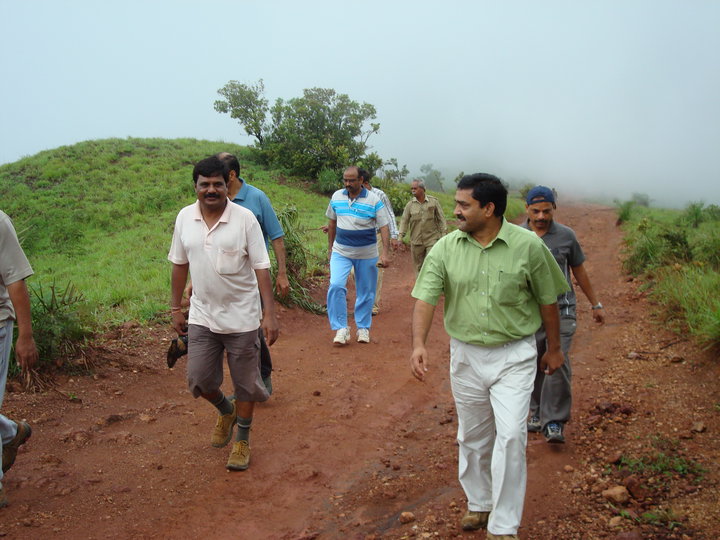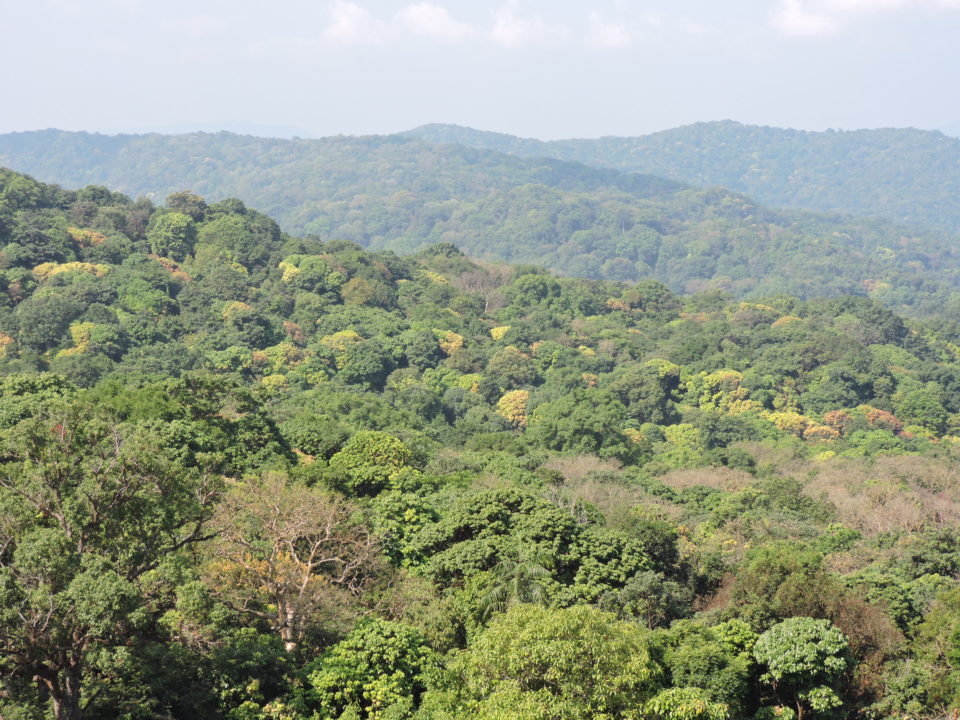A holistic view of conservation that looks at a diversity of habitats and species is the focus of the Chief Wildlife Warden of Karnataka, Sanjai Mohan, IFS.
 Sanjai Mohan, IFS is the Chief Wildlife Warden and PCCF (Wildlife), Karnataka
Sanjai Mohan, IFS is the Chief Wildlife Warden and PCCF (Wildlife), Karnataka
Working as a forest officer, often it calls for a combination of quick thinking and a binding belief in one’s duty to protect wildlife, when caught in a tough situation. So it was that the then ACF of Koppa, Sanjai Mohan had handed over charge on transfer and was packing his bags when the range staff came running to him with anxiety writ all over their faces. A leopard was stuck in a snare near the edge of the forest adjoining paddy fields. It being a Sunday and the vet not available, Sanjai had to take a quick decision. He rushed to the spot, determined to save the leopard.
At the spot a huge crowd of villagers had gathered and the leopard seemed to be in a semi-conscious state, perhaps tired from trying to escape the noose around its neck since the previous night. Sanjai quickly called for a long bamboo pole and a saw blade and secured the blade to the pole firmly. Next was the search for an able-bodied person who could hold the pole, slip it under the noose wire and saw the wire slowly without hurting the animal.
A villager volunteered and the rescue act began, thankfully with the tired leopard not moving much. After half an hour the wire was cut but the leopard lay still. Just when apprehension was mounting that it was too late a rescue, the animal pounced on the man who had cut the wire. As the villager fought the animal, Sanjai signalled his staff to fire into the air. The sound had an effect and the leopard left the man but turned to Sanjai. In a quick movement, he turned and had a fall off the paddy field bund that left him with a disjointed shoulder. Luckily, the distracted leopard turned and vanished into the forest. The villager survived with some injuries and was adequately compensated and taken care of.
That was in 1999. Today, the officer heads the wildlife division of the Karnataka state forest department. Sanjai Mohan, IFS from the 1985 batch of the service, is presently the Principal Chief Conservator of Forests (Wildlife) and the Chief Wildlife Warden, Karnataka. He has earlier been Managing Director, Karnataka Forest Department Corporation as also of the Jungle Lodges & resort, having worked in the research wing as APCCF. He has also worked at the Centre with the GoI for five years.
He has some well-thought out plans for nurturing the wildlife and forests of Karnataka. These are not restricted to the big charismatic species like the tiger, leopard and elephant.

The officer in the field
For one, the PCCF recognises the need to protect grasslands, “an important habitat” which stores up to 30% carbon besides hosting important species. Studies have shown that grasslands converted to forests resulted in many streams inside shrinking or drying up. “We have been thinking only of planting trees when we see open land. This must change if we are to protect some of the birds and animals that need the grasslands. Look at the way we have lost count of wolves or jackals or of course, the Great Indian Bustard (GIB) whose numbers have plummeted. In Ranebennur sanctuary too, the numbers of black buck have dropped and there are no GIBs now.”
Talking about the need to develop the habitat, Sanjai Mohan notes that the department proposes to conduct a survey along the eastern plain in the State to look at what animals once lived here in the past and what are sighted today. “We have very little info on this part, as the focus has always been on the Western Ghats. But yes, I feel we need to give equal focus to open lands, wetlands and grasslands. A comprehensive plan is on the anvil,” he says.
Tigers electrocuted, leopards knocked down by speeding vehicles, elephants chased by mobs… how does he feel the situation will improve, especially with wildlife increasingly seen outside protected areas (PAs)? “Yes, conflicts are bound to increase because our forests are limited and numbers of animals are increasing. With their requirements of range and territory, some will spill out of protected areas. We are doing our best in whatever way possible like building trenches and fences wherever possible but as I said the wildlife needs to move and we can’t keep them locked in. That is where it is important to secure wildlife corridors,” he points out, noting how young tigers need to disperse to find new territory.
The PCCF is also quick to point out that Karnataka is also the only state in the country that has been continually adding new protected areas to aid conservation. The state had announced recently the expansion of two protected areas and addition of a new conservation reserve. These are the Sharavathi Valley LTM Sanctuary, Cauvery Wildlife Sanctuary and the Kolar leaf-nosed Bat Conservation Reserve. “It goes without saying we cannot keep adding these areas either. However, Karnataka has 25% of its geographical area under PA status and that is proof of our conservation intent,” he says, adding that the other solution to addressing conflict was timely and adequate compensation to those affected. While there is a proposal to increase the compensation for human death from Rs 5 to 10 lakh, there is also a similar move to increase rates for cattle and crop loss, he says.

Sharavathi Wildlife Sanctuary has been expanded to include new areas
Finally, there is also the role that a well-planned voluntary relocation can play in easing the pressure on habitats, wildlife and the people. “When people move out of protected areas, it improves the quality of habitat inside for prey and predator species besides big mammals like elephants. However, the focus is on the word ‘voluntary’ and the people should want it. But yes, it is a costly affair as can be seen with the Kudremukh relocation process. Around Rs 5 crore is allotted every year for that area alone but with people also holding land inside, they have to be adequately compensated if they have to move out. On an average we are able to move only 12-13 families with the Rs. 5 crore, while there are over 300 families who have sought relocation and are waiting,” the PCCF explains, adding that the process could be hastened if the state government allotted more funds.
He points to Nagarahole where around 700 odd families have been resettled. “That has been a good rate, but of course Bhadra relocation stands out as a model simply because all the people were convinced and were willing to relocate. Elsewhere, some prefer to stay back and that means there is still going to be disturbance to the habitat and wildlife.”
Sanjai Mohan is keen to pursue voluntary relocation in other areas like Anshi Dandeli, where a few have relocated but still many live inside in remote areas. “I know the situation there. Life is tough in those places where they are cut off from outside world sometimes. However, most of these people have land inside and to buy that, we need a lot of money.”
Recent reports like the IPBES and Living Planet index have painted bleak scenarios of a world where the wildlife is being decimated at a fast pace, down by 60% from 1970. What does he feel about the same? Is there hope that our coming generations will be able to feel the joy of watching animals in the wild? “True the trend is pretty dismal and despite all our efforts, we may fail. But at least within our PAs, we can protect wildlife. However, factors outside may affect the inside too, like water scarcity, resources, climate change, yes the diversity may eventually get eroded. We can only hope for the best.”
That is where he believes education and spreading the word could help. One of his pet projects has been to spread awareness about moths, butterflies and insects. “They are all vital components of our eco-diversity,” the PCCF says, noting how Karnataka is one of the few states to have a state butterfly. This is the black and yellow Southern Birdwing, Troides minos, with a wingspan of 140-190 mm, the largest butterfly in India. It can fly to heights of 30-40 feet and cover many kilometres at a stretch. Sanjai Mohan was responsible for proposing the Southern Birdwing as the state butterfly.

State butterfly of Karnataka: Southern birdwing
He is happy that a moth festival was held in the State recently, on the lines of the butterfly festival held two years ago. He would also like to focus attention on conserving fish species, like the “mahseer which seems to have been affected by alien species introduced into the system.”
Sanjai believes education is the key, reminding one of the oft quoted words of environmentalist Baba Dioum : ‘we will conserve only what we love; we will love only what we understand and we will understand only what we are taught.’
Written by Jayalakshmi K